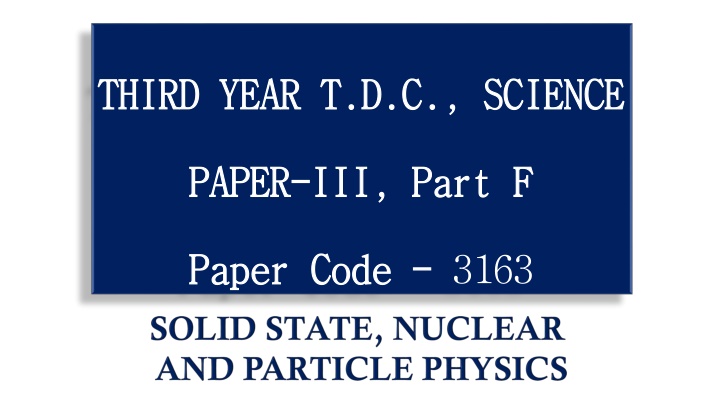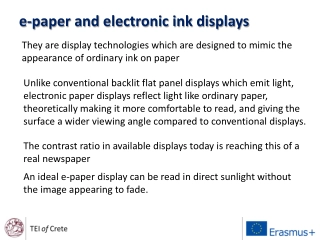
Crystallography: Understanding X-ray Diffraction in Crystals
Explore the fascinating world of crystallography and X-ray diffraction in crystals. Learn how X-rays interact with crystal lattices, revealing the atomic arrangements and creating diffraction patterns essential for crystallography research. Delve into the principles behind crystal diffraction effects, from scattering to path lengths, providing a foundational understanding of crystallography.
Download Presentation

Please find below an Image/Link to download the presentation.
The content on the website is provided AS IS for your information and personal use only. It may not be sold, licensed, or shared on other websites without obtaining consent from the author. If you encounter any issues during the download, it is possible that the publisher has removed the file from their server.
You are allowed to download the files provided on this website for personal or commercial use, subject to the condition that they are used lawfully. All files are the property of their respective owners.
The content on the website is provided AS IS for your information and personal use only. It may not be sold, licensed, or shared on other websites without obtaining consent from the author.
E N D
Presentation Transcript
THIRD YEAR T.D.C., THIRD YEAR T.D.C., SCIENCE SCIENCE PAPER PAPER- -III, III, Part F Part F Paper Code Paper Code - - 3163
UNIT 1 : CRYSTALLOGRAPHY Diffraction of X-rays by a Crystal Lattice Since X-rays are electromagnetic radiations, they interact with the electron cloud of atoms The diffraction pattern will give information the arrangement of atoms in crystals resulting X-rays typically have wavelengths of the order of few . of internal The spacing between adjacent atoms in a crystal is also of the same order O riginal X made by W illiam B ragg at L eeds U niversity O riginal X - -ray spectrometer made by W illiam B ragg at L eeds U niversity ray spectrometer Thus, X-rays are scattered by adjacent atoms in crystal Since each atom can act as a diffraction centre, the crystal as a whole acts like a three dimensional diffraction grating. This gives rise to diffraction effects 2
UNIT 1 : CRYSTALLOGRAPHY Diffraction of X-rays by a Crystal Lattice Consider a crystal made up of equidistant parallel planes of atoms as shown in the figure Let the distance between the planes be d Let a monochromatic beam of X-rays with wavelength and having a common wavefront fall at an angle on these planes The atoms scatter X-rays almost uniformly in all directions 3
UNIT 1 : CRYSTALLOGRAPHY Diffraction of X-rays by a Crystal Lattice Let 2 of the incoming X-rays, OE (falling on atom at E) and O A (falling on an atom at E) be inclined at an angle with the top most plane of the crystal Let them be scattered in the directions AP and EP They also make an angle with the top most plane of the crystal Since the path length of the rays OEP and O AP are the same, they arrive at P and P in phase with each other and also forms a common wave front. 4
UNIT 1 : CRYSTALLOGRAPHY Diffraction of X-rays by a Crystal Lattice Again consider the incoming beam O C (falling on an atom at C) and the scattered ray CP If EB and ED are parallel to the incident and scattered wave fronts respectively, then the total path O CP is longer than OEP (or O AP) by a quantity =BCD=2BC But from the figure, BC=EC Sin and EC=d Or, =2BC=2dSin 5
UNIT 1 : CRYSTALLOGRAPHY Diffraction of X-rays by a Crystal Lattice If the scattering from two consecutive planes are in phase with each other, then, =n (integral multiple of the wavelength) Or, =2dSin = n where, n=0, 1, 2 etc. gives the order of the reflection Thus the condition for in-phase scattering by a set of equidistant parallel planes in a crystal is given by 2dSin = n This expression is called the Bragg s law after W. L. Bragg who first derived it. 6
UNIT 1 : CRYSTALLOGRAPHY Diffraction of X-rays by a Crystal Lattice The diffracted beams arise only for certain discrete values of for which the Bragg s condition is fulfilled However, the maximum value of Sin is 1 Using this in the Bragg condition we get that?? William Lawrence Bragg was youngest Nobel Laureate in Physics upto now, who was 25 years old when he was awarded the Nobel Prize together with his father (William Henry Bragg) in 1915. 2? 1 Or, at best n =2d This means that cannot be greater than twice the lattice spacing or diffraction cannot occur This means that cannot be greater than twice the lattice spacing or diffraction cannot occur 7
UNIT 1 : CRYSTALLOGRAPHY Diffraction of X-rays by a Crystal Lattice The diffracted beams arise only for certain discrete values of for which the Bragg s condition is fulfilled Or, =2dSin = n Thus the condition for in-phase scattering by a set of equidistant parallel planes in a crystal is given by 2dSin = n This expression is called the Bragg s law after W. L. Bragg who first derived it. The Bragg derivation is simple but is convincing only because it reproduces the correct result. 8
UNIT 1 : CRYSTALLOGRAPHY Diffraction of X-rays by a Crystal Lattice Thus, reflections from all periodic parallel planes add up in phase to give a strong reflected beam for only certain values of . If each plane were perfectly reflecting, all the radiation which falls on the first plane (i.e., any wavelength) would be completely reflected and thus there will not be any radiation which is transmitted. Thus, in such a case, only the first plane of a parallel set would see the radiation But in reality, each plane reflects only10-3 to 10-5 of the incident radiation This means that about 103 to 105 planes may contribute to the formation of the Bragg-reflected beam in a perfect crystal. That is why there are only certain values of which add up 9
UNIT 1 : CRYSTALLOGRAPHY Diffraction of X-rays by a Crystal Lattice The Bragg law is a consequence of the periodicity of the lattice In deriving the law, thecomposition of the basis (i.e., the type of atoms) is not referred to However, the composition of the basis determines the relative intensity of the various orders of diffraction (n) from a given set of parallel planes. Example of X-ray diffractogram (this is for Fe3Al which has been milled for various periods) For example, in the figure given, you can see intensity of diffracted X rays plotted as a function of 2 However, the intensities of all peaks are not the same 10
UNIT 1 : CRYSTALLOGRAPHY Diffraction of X-rays by a Crystal Lattice : The Laue equations Thus, reflections from all periodic parallel planes add up in phase to give a strong reflected beam for only certain values of . If each plane were perfectly reflecting, all the radiation which falls on the first plane (i.e., any wavelength) would be completely reflected and thus there will not be any radiation which is transmitted. Thus, in such a case, only the first plane of a parallel set would see the radiation But in reality, each plane reflects only10-3 to 10-5 of the incident radiation This means that about 103 to 105 planes may contribute to the formation of the Bragg-reflected beam in a perfect crystal. That is why there are only certain values of which add up 11

















